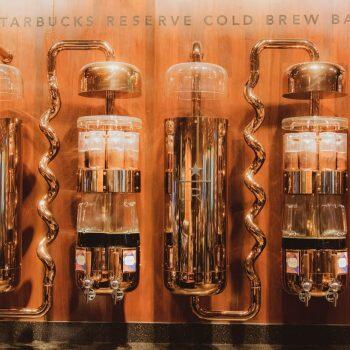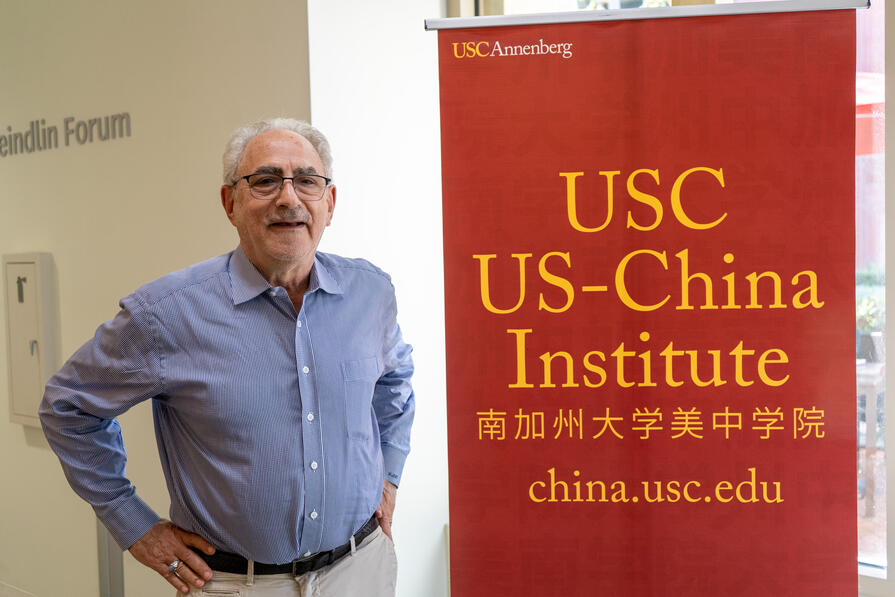Originally published by US-China Today on June 28, 2019. Written by Rebecca Harbeck.
Coffee culture in Beijing and Shanghai fits the fast-paced cosmopolitan character of those cities. With coffee shops lined up across these populous streets, coffee has established itself as a trendy, Western luxury. From business meetings at the Starbucks in the upscale area of Xintiandi, Shanghai to multicultural get-togethers at the expat-friendly Baker and Spice on Anfu Road, coffee has become a cultural icon in mainland China.
Though coffee has been popular in the West for 150 years, its emergence in China is recent. China’s tea-centric culture was relatively untouched by Western coffee retailers until the late 1990s, when Starbucks first entered the Chinese market. Given China’s huge population, coffee companies have found a market in China that they hope to develop. More importantly, the emergence of coffee in China represents the new dominance of a previously uniquely Western influence, and coffee itself serves as an exhibition of social status and cosmopolitanism.
Emergence of Coffee in China
For millennia, China has been a tea-drinking society. China is the lead producer and consumer of tea in the world: in 2014, The Atlantic found China consumes 1.6 billion pounds of tea per year. In 2017, China produced over 2.4 million tons of tea. This is nearly double that of the second largest tea producer in the world, India.
Even so, coffee is growing increasingly popular, reflecting expanding tastes. Sellers see great commercial potential. “At that time, in 2006, there was little specialty activity and very little coffee consumption,” coffee trade expert Andrew Hetzel says. “And yet, everyone within the coffee industry recognized that there was a tremendous opportunity.”
The coffee industry has come a long way in the past 13 years. “In 2006, there were very few multinational chains that were present,” Hetzel says. “It was very difficult to find a cup of coffee outside a Western hotel or Western area.” However, over a decade later, this is no longer the case. “You have representation from many large multinational chains–as you have seen, last week [referring to the opening of Shanghai’s Starbucks Reserve], Starbucks is expanding at a blistering pace,” he says. The rapid rise of Starbucks in China signaled a shift in beverage culture in China.

Coffee Influencers: The West
Starbucks Coffee’s first shop opened near Pike Market in Seattle, Washington. Since 1971, Starbucks has emerged as one of the most well-known multinational enterprises in the world. However, Starbucks did not enter the Chinese market until the late 1990s, when Lawrence Maltz brought China’s first Starbucks to the lobby of the China World Trade Building in Beijing. Maltz realized the strategic first-mover’s advantage of entering an untapped market. In a December 1999 interview with CBS News, Maltz said, “It would be foolish for us to wait until coffee was well entrenched in China.”
Today, Starbucks dominates the Chinese coffee market. The world’s largest Starbucks is located in Shanghai and is the second Starbucks Reserves to be created. The Reserve serves as a space to showcase its “most extraordinary coffees.” Currently, there are fewer than half a dozen Starbucks Reserves in the world, and the Shanghai Reserve is bustling with both Chinese nationals and tourists, looking to learn more about the coffee craft, buy fancy coffee equipment, or share a cup of joe with good company. In addition to the Reserve, according to CNBC a new Starbucks emerges every 15 hours in China to keep up with rising demand. By 2022, the company aims to have 6,000 stores in 230 cities. Despite China’s economic slowdown, Starbucks’ revenue has grown in the past year. From December 31, 2017 to December 30, 2018, there was a 92% increase in revenues from $340.2M to $651.8M. With an increase in over 500 stores in that year, Starbucks expanded its physical capital as well.
 The sheer number of Starbucks shops isn’t the company’s only impressive feat. Starbucks is also increasing its geographic diversity. At first, Starbucks stores were only found in large, coastal Chinese cities. However, they have since expanded throughout the country. “You can probably find a Starbucks just outside of your complex or next to the subway stations,” says Ms. Jiang, a Starbucks barista in Changzhou, a city in southern China near Suzhou.
The sheer number of Starbucks shops isn’t the company’s only impressive feat. Starbucks is also increasing its geographic diversity. At first, Starbucks stores were only found in large, coastal Chinese cities. However, they have since expanded throughout the country. “You can probably find a Starbucks just outside of your complex or next to the subway stations,” says Ms. Jiang, a Starbucks barista in Changzhou, a city in southern China near Suzhou.
Other Western coffee companies have also entered the Chinese market, such as Britain’s Costa Coffee, Canada’s Tim Horton’s, America’s Dunkin Donuts and the Swiss Nestlé. Costa Coffee has remained quite popular in China, setting up a loose rivalry with Starbucks, while others like Dunkin’ Donuts have not fared as well. Nevertheless, Starbucks remains a dominant player with nearly 60% of the coffee market share in China.
 A strong Western influence has manifested itself through the rise of coffee in China. Hetzel attributes much of coffee’s success in China to the millennial generation. “I think it is driven by the younger generation, clearly,” says Hetzel. “It is an overall demand for modern culture. That is what is driving the change entirely. There is an interest in developing and becoming part of the middle class, doing better than your parents.” The rise in coffee consumption has coincided with an interest in “economic achievement” and the “adoption of Western style,” according to Hetzel.
A strong Western influence has manifested itself through the rise of coffee in China. Hetzel attributes much of coffee’s success in China to the millennial generation. “I think it is driven by the younger generation, clearly,” says Hetzel. “It is an overall demand for modern culture. That is what is driving the change entirely. There is an interest in developing and becoming part of the middle class, doing better than your parents.” The rise in coffee consumption has coincided with an interest in “economic achievement” and the “adoption of Western style,” according to Hetzel.
During a walk down Shanghai’s Nanjing Road, an upscale shopping area, I passed the local chain See Saw’s, a handful of Starbucks, and another half-dozen cafes that served coffee. Although coffee consumption didn’t take off until the mid-2000s, its current popularity in China is undeniable.
China’s coffee market also has ample room to grow. Currently, China’s per capita coffee consumption is only at five cups per year, whereas the U.S. is at 400 cups per year and countries in Europe like Norway and Sweden are above 1,000 cups per year.
Coffee: A Status Symbol
At the Starbucks in the USC Village, my tall, black Americano costs just $2.15. Given Los Angeles is one of the most expensive cities to live in, this is the price I pay for coffee. When I was in Shanghai over spring break, I spent nearly a dollar more for the same drink. Though regular meals in Shanghai are comparatively cheaper (I had several meals for under 25 RMB or $3.72 USD), and the minimum wage is around $10 less than Los Angeles’, coffee in Shanghai is relatively expensive. Except for coffee at the boba shop Coco’s or McDonald’s, I shoveled out around $4-6 USD for my caffeine fix.
Market research from the international bank UBS ranking the world’s most and least expensive cups of coffee confirms that coffee in China is costly. A cup of coffee in Doha, the capital of Qatar, topped the list with a price of $6.40 USD. Chinese powerhouses Shanghai and Beijing didn’t come far behind, with prices of $4.60 and $4.42 respectively.
The Atlantic argues coffee has been used to signal a certain lifestyle and status in mainland China. Though the prices may appear perplexing, the consumption of high-priced coffee reflects the same motivations behind buying luxury, designer goods. Though the per capita income in the U.S. is five times higher than that in China, coffee prices in China are even more expensive. The Atlantic states that “high prices actually entice customers who wanted to show off their new affluence.” For coffee consumers in China, Starbucks and other Western coffee brands enable them to show off their wealth and good taste.

In one week, I carried out ethnographic research in five coffee shops in Shanghai and one in Suzhou. The Starbucks in the Xintiandi shopping area of Shanghai had a minimalist, spacious first floor with a populous outdoor seating patio, and a dimly lit second floor with a seating arrangement that invited business engagements, friendly conversations, and individual workers at the long, communal table in the center. Most of the customers were Chinese, many of whom were well-dressed in business casual attire. Some typed away at their Lenovo computers while others engaged in deep conversations with business partners. I ordered a tall Americano for 25 RMB ($3.72 USD), the cheapest drink on the menu. However, I noted speciality drinks that cost over $7 USD and the ice cream snack items available for sale alongside Starbucks’ usual menu of sandwiches, breads and cakes.
 The Baker and Spice on Anfu Road in Shanghai had a clean layout, dim lighting, warm air and indie-alternative English music playing in the background. The menu was filled with options ranging from coffees and teas in the $5-6 USD price range to healthy juices. The bakery had slices of cake starting at $4 USD, donuts for $2 USD and an assortment of homemade breads. As I walked to my table, I passed two French couples immersed in passionate conversation over half-full lattes and Americanos. At the center table, many people were engrossed in their work: one tall, blonde man creating graphic designs, two college-aged students working on an assignment and two Americans bidding each other farewell. This cafe had all the characteristics of an American coffee shop with the conversationalists, the workers, and high-end beverages and baked goods.
The Baker and Spice on Anfu Road in Shanghai had a clean layout, dim lighting, warm air and indie-alternative English music playing in the background. The menu was filled with options ranging from coffees and teas in the $5-6 USD price range to healthy juices. The bakery had slices of cake starting at $4 USD, donuts for $2 USD and an assortment of homemade breads. As I walked to my table, I passed two French couples immersed in passionate conversation over half-full lattes and Americanos. At the center table, many people were engrossed in their work: one tall, blonde man creating graphic designs, two college-aged students working on an assignment and two Americans bidding each other farewell. This cafe had all the characteristics of an American coffee shop with the conversationalists, the workers, and high-end beverages and baked goods.
Unlike Baker and Spice, Cafe On Air was filled with local Chinese customers. The minimalist design fit well with the millennial crowd the cafe attracted. Chinese filled the room, sitting at stark wood tables as they peered outside to look at the greenery. Like Baker and Spice and Starbucks, Cafe On Air’s beverages were expensive. An Americano was a steep 28 RMB ($4.17) and a basic flat white was 34 RMB ($5.06).
NYU-Shanghai student Yoyo indicated many cafe-goers in China choose coffee shops for their aesthetic purposes and ambiance. As a coffee-lover herself, she has spent hours studying and socializing in the various cafes and coffee shops in Shanghai. “There are commonly more young girls with friends,” Yoyo says, specifying that cafes tend to be populated with those in their teenage years and mid-adult life. In these cafes, they are “chatting and taking selfies,” while middle-aged men and women are “reading books or working.”
The Shanghai coffee shops attract a younger, more millennial population because most of them have “fancy interior designs,” which allow individuals to take “fancy photos” and “selfies” there. Yoyo indicated being perceived as young and fashionable remains important, as it allows individuals to “build a perfect digital self.” In China, like many parts of the world, having a strong social and digital presence is a priority.
Homegrown Coffee
Coffee production in China is rising. Yunnan Province shares some of the same characteristics that enable producers in South America and Africa. Currently, 95% of the coffee produced in China comes from Yunnan Province and over 100,000 tons of coffee are produced annually.
Photographer Aaron Berkovich captured coffee production in Yunnan from 2011 to 2013.
In Yunnan, he met with and photographed Chinese coffee farmers who were part of GoodWorks Coffee, a nonprofit that helps coffee farmers increase their returns on investment. According to Berkovich, GoodWorks Coffee helps local coffee farmers throughout multiple steps of the coffee production process and had successfully “tripled annual return for some of these farmers,” which drew Berkovich to the project.
During his two years in Yunnan, Berkovich noted that production had risen, output became more predictable and sustainable, and the quality of the beans produced was higher. He also reported growers received strong returns that supplemented their incomes from other crops like mangos.
Planting coffee is a long-term investment and patience is required to earn a payout. Berkovich argues, though, that farmers “wanted to diversify crops to increase revenue and earn some more money.” In contrast, Berkovich stated that others started growing coffee as they “connect with friends. In many towns – one person does it and then everyone else joins in.”
In addition to homegrown coffee beans, China has several of its own homegrown coffee shop chains. In early 2018, start-up unicorn Luckin rocked the coffee industry by vying for Starbucks’ market share. Since its inception in 2017, Luckin has opened more than 2,300 stores and “serves lattes at prices about 30 percent lower than Starbucks and provides subsidised deliveries to office workers,” according to the Financial Times. Currently, it owns stores in 13 cities and aims to expand
At a shopping center on Nanjing Road in Shanghai, an Americano at Luckin is significantly cheaper than Starbucks, costing only 21 RMB ($3.13 USD) as opposed to Starbucks ($3.72 USD). Their lattes were also relatively cheaper than competitors, with a price of 24 RMB ($3.58 USD) and their speciality flavored lattes, including matcha and black tea, were only 27 RMB ($4.02 USD).
The value of Luckin’s coffee is what attracted its growing customer base. While Starbucks played an integral role in bringing coffee to China, Chinese consumers can now get their caffeine demands met elsewhere. In mid-May, Luckin went public on the U.S. market and had a strong debut day as it was heavily anticipated by those in the tech and coffee industries. Although Luckin’s (“LK” on the Nasdaq) went from its I.P.O. price of $17 to $25 in a few days, the price has continued to fluctuate on a downward trend with a low of $14.75 on May 22. Luckin’s I.P.O. recently followed poor performances from American companies Lyft and Uber’s I.P.O.s and came amidst a growing trade war between the U.S. and China, so the timing could account for the company’s I.P.O. performance. However, leaders in the coffee industry and business sector warn about too much optimism in Luckin, as they do not see its business model as sustainable or profitable long-term.
The Future of China’s Coffee Industry
Coffee shops and coffee consumption are rising in China. Both foreign and domestic chains are growing, as Starbucks and Luckin take the lead. Business experts like Hetzel see that these chains are a long way from meeting the rising demand for a nice, coffee shop experience.
China’s 400 million millennials are the top target for these chains. As Hetzel puts, many want to manifest their membership in the coffee-sipping middle class. Through incorporating coffee into their day-to-day, Chinese individuals have been able to adopt aspects of Western culture. In the upcoming years, coffee chains will continue to vie for market dominance.
Cover photo by Emma Cockerell.




